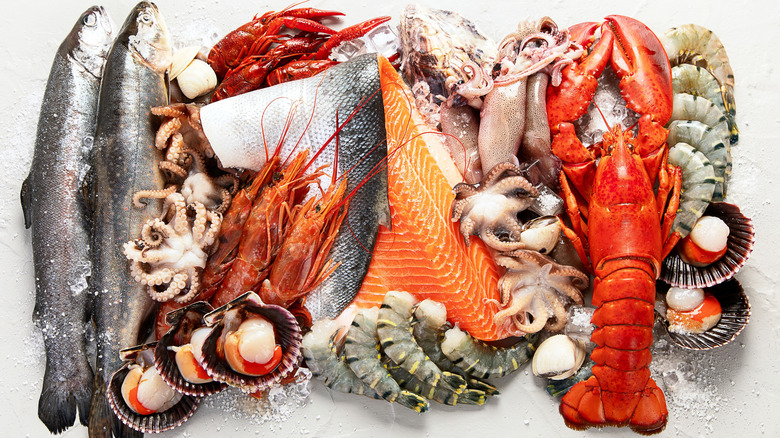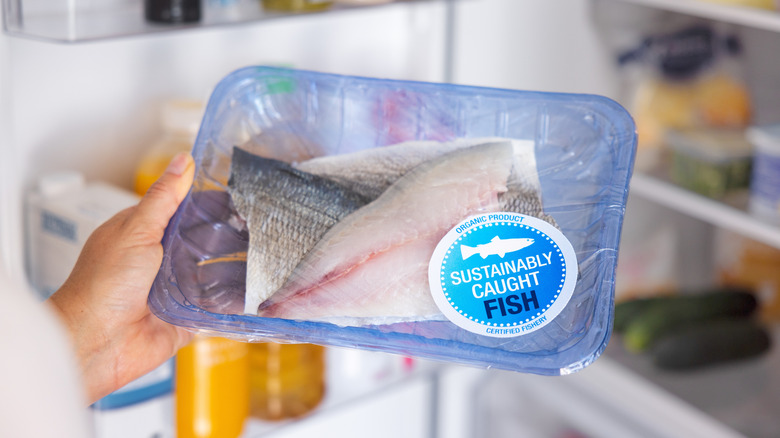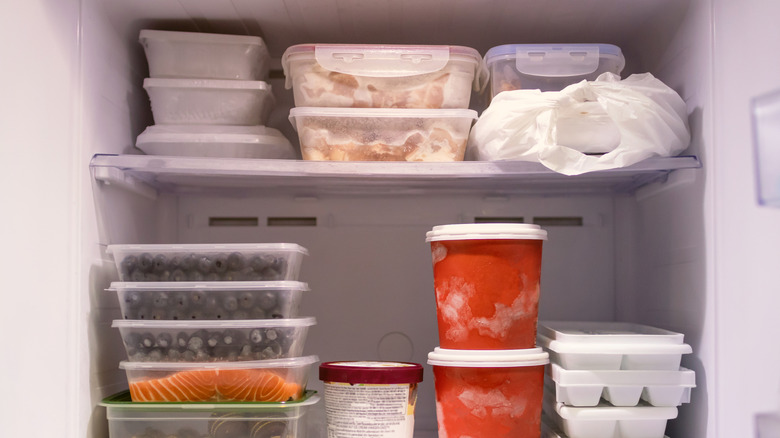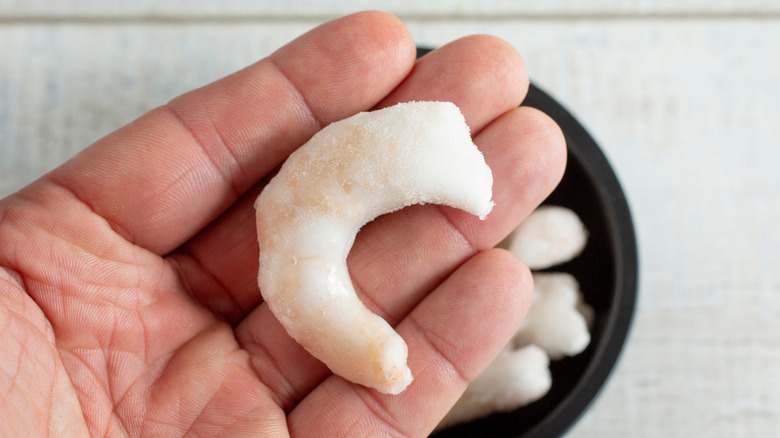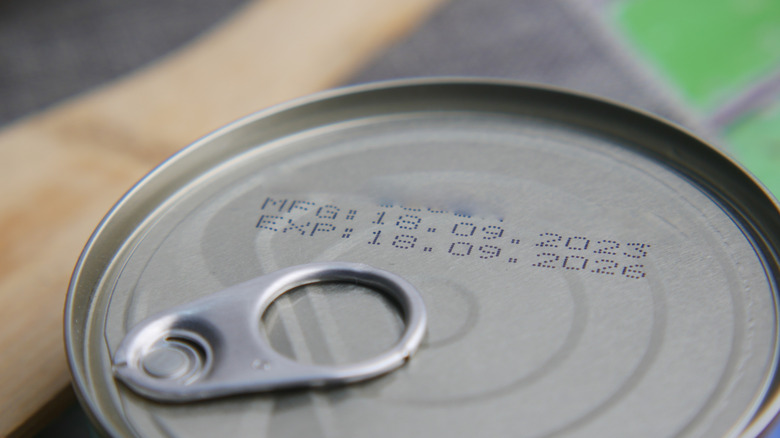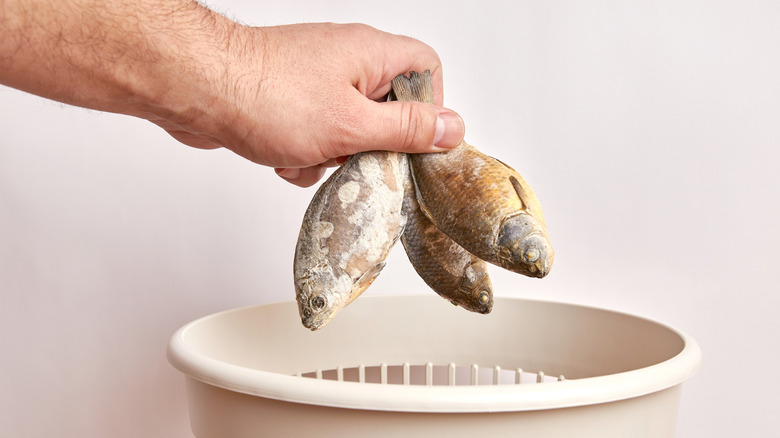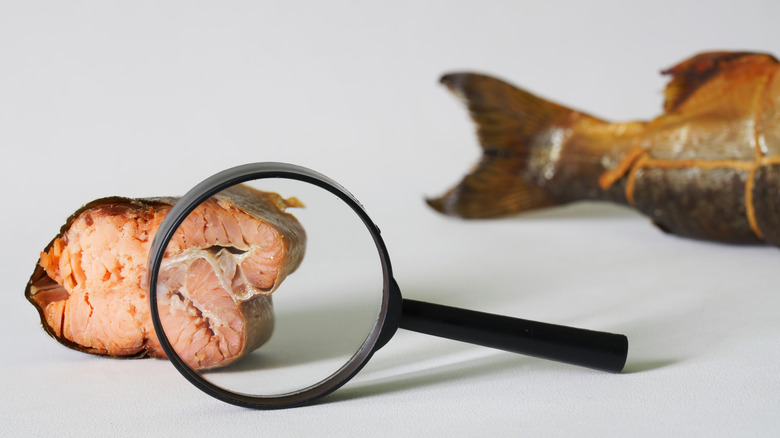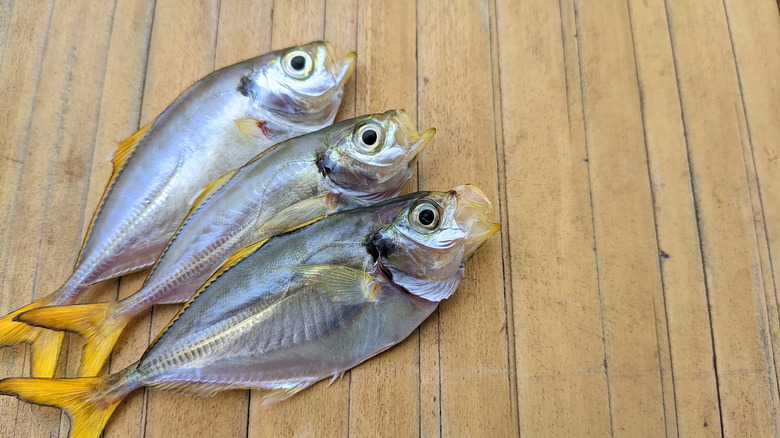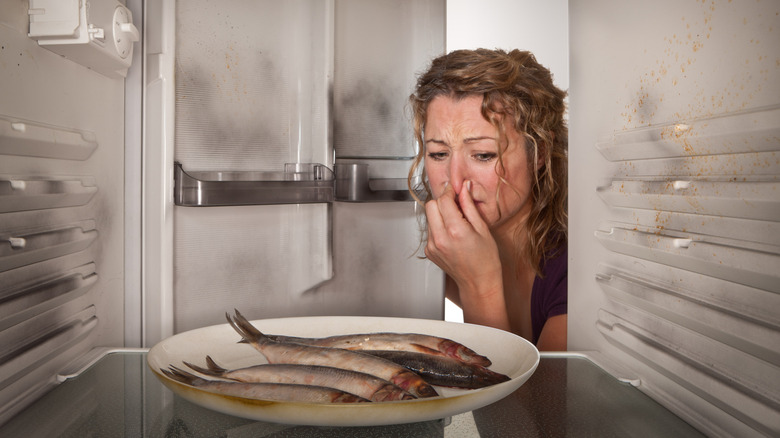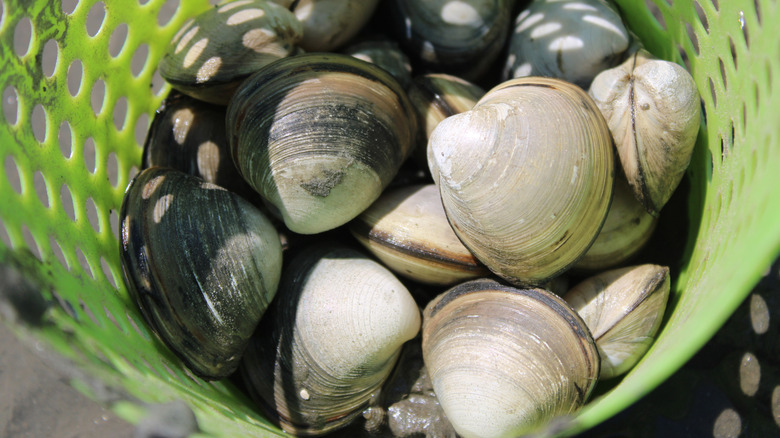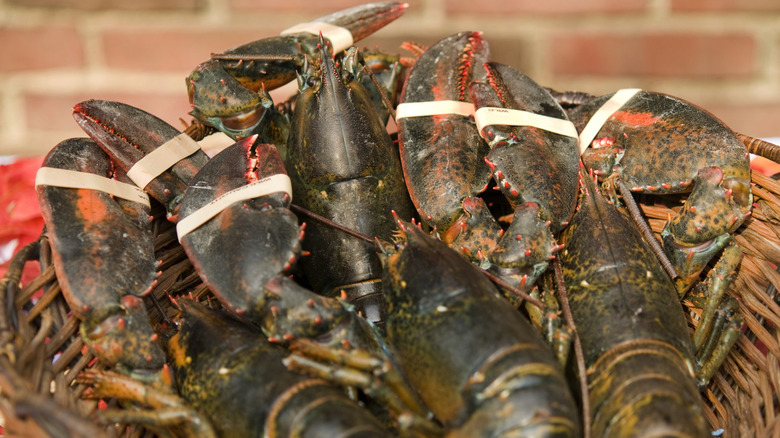Seafood Experts Uncover Signs Your Seafood Has Spoiled
Spoiled seafood is no joke. If you eat it, you run the risk of getting sick — like, really sick. Not to mention the taste and texture will be downright awful. To avoid potential consequences, it is important you understand what signs point to seafood spoilage. Otherwise, you could be in for a rough couple of days. Fortunately, once you know what they are though, they'll be hard to miss. Even so, if you are ever in doubt, it's best to simply toss out the seafood in question — it's never worth the risks that accompany consuming spoiled seafood.
To find out what all the warning signs of seafood spoilage are, I interviewed three experts on the matter. For starters, I received some helpful insights from Shelley Balls, MDA, RDN, LDN. She's a registered dietitian and nutritionist for Consumer Health Digest who just so happens to be ServSafe Manager Certified, as well. The director of food safety at Wild Alaskan Company, Monique Moore, also weighed in with a few tips on spotting seafood spoilage. Last but not least, Dennis Littley, a chef with over 40 years of experience working in fine dining and the recipe expert at Ask Chef Dennis, offered a myriad of things to look out for. Keep reading to find out what they told me, and believe me, your stomach will thank you.
Your seafood has been in the fridge for more than a few days
The window of time for you to consume fresh seafood is pretty limited, at least in the fridge. All of our experts agree that you really only have about one to two days to cook or freeze fresh seafood before it spoils. Fine dining chef and recipe expert Dennis Littley said you may be able to extend the time for shellfish to two to three days, but only if it is stored properly, i.e. in its original packaging or on ice. Still, for fish, one to two days is the max. The director of food safety at Wild Alaskan Company, Monique Moore, also stressed that it is important to keep your refrigerator at 40 F or less.
If you are approaching the one to two-day max, it's best to cook seafood. After cooking, you get another three to four days before it is considered spoiled. You could also opt to freeze your seafood instead, but Shelley Balls noted that "the longer you store it the more the flavor and texture will degrade." As a result, it is always best to simply cook and enjoy fresh seafood as soon as possible.
Your seafood has been in the freezer for more than eight months
Storing seafood in the freezer buys you quite a bit of time before spoilage. However, as Shelley Balls told us, the longer you store it, the more the flavor and texture will suffer. Even so, Monique Moore from Wild Alaskan Company said, "Outside of catching seafood that day, the next best thing is frozen seafood." When stored at 0 F or below, she told me seafood can basically stay good indefinitely. However, she also noted that Wild Alaskan Company recommends consuming frozen seafood within 24 months to ensure you get the best quality.
Balls, on the other hand, gave me a much shorter window for consumption: Three to four months. She also told me you can freeze cooked fish, but it should not be frozen for more than three months before you toss it out. With all of these numbers being tossed around, it can get kind of confusing. What's most important is that you know the longer seafood is frozen the more it deteriorates. You also want to keep your freezer cold enough that seafood stays frozen solid. If you do, it won't spoil for a very long time.
Your seafood has freezer burn
Freezer burn is kind of a tricky one. If you pull seafood out and notice freezer burn it doesn't necessarily mean it is unsafe or spoiled. As the director of food safety at Wild Alaskan Company Monique Moore told me, "It depends on the severity of the dehydration and amount of time it has been in the freezer. If it's minor burning, you can still enjoy the fish if you trim the affected area off." However, if you detect a spongy texture and notice lots of discoloring, she recommends discarding it.
Dennis Littley agrees freezer burn isn't a hard and dry line for spoilage. Still, he told me it will impact quality: "Fish with freezer burn can taste dry or flavorless, and its texture may suffer." When the freezer burn is minimal, he recommends simply trimming off the affected portions and cooking like normal. It's only when freezer burn becomes extensive that he says you should probably just get rid of it.
Whenever possible, it is best to vacuum seal seafood before freezing. It goes a long way in preventing freezer burn. If this isn't an option, use an airtight container and if you notice freezer burn on your seafood, keep in mind what our experts recommend. You may not have to toss it out, but you should definitely expect a decrease in overall quality.
The expiration date on your seafood has passed
Many people believe expiration dates are a hard and fast rule and anything that passes the date should immediately be tossed. As it turns out, this is not necessarily true though. Monique Moore told me that best if used by dates are a good indicator of optimal freshness, but they are "not a food safety date, food can still be good after this date if it has been handled and stored properly." Fine dining chef Dennis Littley agrees with Moore but says you should be aware of any other signs of spoilage, like smell and aroma, which we will discuss later on.
Registered dietitian and nutritionist for Consumer Health Digest Shelley Balls takes a different approach: "Expired seafood is definitely not something you want to mess around with. I would highly recommend tossing unfrozen fish that has passed its expiration date in order to prevent a food-borne illness." So, as you can see, the experts aren't necessarily aligned on this. Either way, just make sure to toss your seafood on the grill or cook it up however you like before the expiration date passes and you won't have to worry about it.
The color starts to change
When seafood starts to change color it is a surefire indicator of spoilage. Of course, the color of any specific type of fish can vary somewhat based on their environment and diet, or even how they were packaged, but any change from the initial fresh color (whatever it happened to be) is a reason for concern. Shelley Balls told me when it comes to fish, the color starts to fade and may even develop a blue-grey hue. In addition, "the fish gills will start out bright red, then turn dark red, light brown, brown, dark brown, then green as time progresses."
Dennis Littley confirmed what Balls told me about the discoloration of fish and said, "Color changes are one of the easiest ways to tell if seafood is off." As a result, it is a great place to start evaluating any questionable seafood.
For shrimp, both Balls and Littley said a milky, cloudy, or yellowish tint develops with spoilage. Overall, it appears dull, as opposed to fresh shrimp which has a bright, transparent color. Don't miss this red flag! All this being said, your seafood could spoil before it starts to change color. That's why it's best to be aware of all the different signs of spoilage and not rely on shifting color alone.
The texture becomes slimy or mushy
If your seafood makes it past a visual inspection, it's time for a quick feel. Fresh fish have firm flesh that springs back after applying pressure. Anything less than this and it's not a good sign.
According to Shelley Balls, "When seafood spoils you may notice it has a slimy, soft, tacky, or mushy texture." Yuck! If this happens, it's time to say goodbye. Even so, Monique Moore revealed that some fish naturally have a slimier texture than others, so again, it is important to look for more than just a slight slickness on the skin.
Fine dining chef Dennis Littley agrees with our other experts and added that shellfish like scallops also fall prey to a mushy texture when spoiled. So pretty much across the board mushy indicates the point of no return. Even if it didn't, texture is half the fun of fresh seafood, don't settle for less.
Fish tails start to dry, fray, or curl
Fresh fish tails are flat and somewhat moist. They certainly aren't curled or fraying. If you ever notice a change like this in the tails of your fresh fish, tossing them out is your best bet. According to Shelley Balls, "Fish tails curling, fraying or drying out may be an indicator that it has been stored longer than two days, and not kept at a safe temperature." So, even if your fresh fish hasn't been in the fridge for more than two days, the tails can alert you to improper storage conditions, which no surprise here, cause it to spoil much faster.
If you simply can't remember how long your fresh fish has been in the fridge, it is a bad sign regardless, but if it gets to the point where the tails exhibit any of the warning signs described by Balls, don't mess around. As our experts can't stress enough, it is always best to play it safe when it comes to your health and safety regarding spoiled seafood.
Fish with milky or cloudy eyes
The freshest fish have super clear eyes that you could easily imagine looking at you from inside the case or packaging. If they don't, it is a sign that they might be spoiled, or at least close to it. Shelley Balls said you should look out for cloudy or milky-colored eyes. If you spot them, it's a good sign they are spoiled. Similar to the rest of the fish, discoloration is not a good thing. In fact, it's the exact opposite.
When picking out fresh fish, Balls recommends looking for crystal clear eyes, bright red gills, and scales with a bright metallic sheen. Following these guidelines will not only give you more time to cook and enjoy it before spoilage, but it also ensures the fish you pick provides the best possible flavor and texture. Since that's what we all want, you'd be wise to follow her tips.
You detect a strong sour aroma
Probably the most obvious sign of spoiled seafood involves its smell. David Littley put it this way: "Fresh seafood smells briny, like the ocean. If it has a strong, ammonia-like odor or smells sour, it's definitely spoiled." There's no guesswork about it. Even if you think you can simply rinse the smell away, he said there's no washing away spoilage. It is honestly kind of wild that he had to say that but you never know the lengths people will take to avoid wasting food, especially when it comes to more expensive items like seafood.
Monique Moore backed up what Littley told me and added, "Typically these smells get stronger after cooking too." So, even if you miss it at first, there's basically no chance you won't pick it up once it starts cooking. The smell actually goes beyond simply spotting spoiled seafood too. A sniff test can also be used to help you select the freshest fish at the store. Ideally, "Fresh fish should smell clean, like the ocean, not overly fishy or sour," said Littley.
You pick up on a potent ammonia-like flavor
As we now know, spoiled seafood can develop a sour, ammonia-like smell, and guess what? The same can be said for its taste. "Spoiled seafood typically has a strong, unpleasant, ammonia-like flavor, sometimes accompanied by a metallic or sour taste," said Shelley Balls. Our expert Dennis Littley added that an overly fishy or any kind of "off" flavor is a huge warning and it shouldn't be brushed under the rug.
Hopefully, spoiled seafood won't make it all the way to your mouth before you pick up on the warning signs, but if it does and you detect an off-putting flavor, you should stop eating it immediately. As Littley told me, "Spoiled seafood can lead to serious food-borne illnesses, and it's not worth the risk." You never want to look back on the moment you overlooked a strange taste and think to yourself why didn't I stop eating it then? Always play it safe so you don't risk getting yourself or even worse, someone else sick.
Your seafood touches a contaminated surface
Okay, this next spoilage factor to look out for all comes down to you and how you handle your seafood. While not a visual indicator, it is just as important. All of the experts agree that it is imperative to keep kitchen surfaces clean and sanitary. If not, the risk of cross-contamination skyrockets. Amateur home chefs may not realize how severe of an issue this is, but Shelley Balls told me it actually increases the risk for food-borne illness quite a bit. Yikes.
To maintain a safe kitchen for cooking, you need to thoroughly disinfect any surfaces that seafood touches, especially if you think it is spoiled. According Dennis Littley, "Spoiled seafood can harbor bacteria like salmonella or listeria, so cleaning is critical to avoid cross-contamination.” Enough said. I mean, wouldn't it just be the worst if you accidentally got sick due to improper cleaning? Yeah, let's take their word for it and avoid making this mistake at all costs.
Your shellfish is not completely closed or it is dried out
Fresh, edible shellfish like clams, oysters, and mussels come in a hard, closed shell. If they aren't completely closed when you get them home or take them out to cook, they are spoiled and you should toss them out immediately. Registered dietitian and nutritionist for Consumer Health Digest, Shelley Balls said, "You can test freshness by tapping on their shell, if they don't close tightly, it is likely dead and unsafe to eat." Okay, that seems straightforward enough, right?
In addition to the obvious sign of open shellfish being spoiled, you also need to look out for shells that look dried out. According to Dennis Littley, this is another indicator that it is past the point of safe consumption. He also noted that when this happens "the meat inside becomes discolored or mushy," and that doesn't sound appetizing by a long shot. Even so, Balls said you'll likely spot other signs of spoilage, like a potent odor, discoloration, or a slimy texture first. She also told me, "If you find your clams, oysters, and mussels dry out within one to two days you can try covering them with a damp paper towel or cloth to keep them moist," so this sign isn't so cut-and-dry (pun intended). Still, when in doubt, toss it out.
Crustaceans are dead or unmoving
The final tell-tale sign that crustaceans like lobster or crabs are beyond the point of safe consumption is easily spotted. If they are dead or unmoving, they are quite literally goners. If you hate killing live lobster and crabs at home, this may not be what you wanted to hear but that doesn't mean it isn't 100% true. As Shelley Balls put it, "Dead or unmoving crustaceans are not safe to eat! Once a crustacean dies, harmful bacteria quickly multiplies within its body, producing toxins harmful to humans." No, thank you.
Dennis Littley told me the only exception to the rule Balls outlined above is if you know for a fact that the crustaceans in question were recently alive. For example, maybe you had the fishmonger at the store kill them for you when you purchased them. Other than that, it's always best to toss them out. With seafood, better safe than sorry is a motto to live by. Otherwise, you might just regret it and it won't be the kind of regret you bounce back from quickly.

